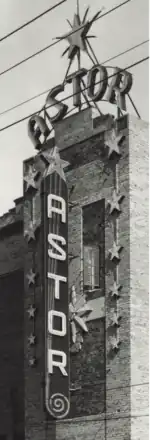| The Astor Theatre | |
|---|---|
 The Astor sign, as first erected in 1935. | |
| General information | |
| Architectural style | Jazz moderne[1] |
| Town or city | Chapel Street, St Kilda (Melbourne), Victoria |
| Country | Australia |
| Coordinates | 37°51′29″S 144°59′31″E / 37.85806°S 144.99194°E |
| Current tenants | Palace Cinemas |
| Construction started | December 1935[2] |
| Completed | 3 April 1936[2] |
| Owner | Ralph Taranto |
| Design and construction | |
| Architect(s) | Ron Morton Taylor[2] |
The Astor Theatre is a classic, single-screen jazz moderne revival movie theatre in the Melbourne suburb of St Kilda, first opened in 1936.
History
The site at 1-3 Chapel Street, St Kilda has been used for entertainment purposes since the the Diamond Picture Theatre opened there on 29 July 1912.[3] It was later renamed the Theatre Rex and closed in 1917. Astor founder Frank O'Collins bought the property in 1935, commissioning architect Ron Morton Taylor who designed the building in the jazz moderne style. Construction work began within a few months, led by the Clements Langford firm.
The Astor officially opened on 3 April 1936 with a seating capacity of 1,673 people. Notably it was one of the last theatres in Melbourne to use the traditional two-level auditorium layout, a costly approach that later fell out of favour. The cinema operated throughout World War II and the post-war era, mostly showing big-name American films from the major studios such as MGM, Paramount and United Artists.[4]
In 1969, the Astor was bought by Tanda Investments and became one of 12 cinemas in Melbourne that played only Greek language films. In the early 1980s, demand from the Greek community declined due to home video and the introduction of SBS, leading to the Astor's brief closure in 1982.
It reopened in 1983 under the leadership of George Florence, who debuted the theatre's new incarnation with a screening of 1933's King Kong. Florence initiated the programming style of the Astor that continues to this day, and designed the classic "calendar" session posters which became popular pin-ups in homes across Melbourne. During this era, the theatre's capacity was reduced to 1,200 so that a stage could be installed for live performances. Many concerts were then held at the Astor throughout the 1980s, including INXS, Midnight Oil and Siouxsie and the Banshees.[5]
In 1998, the Astor was heritage listed by the National Trust.[6]. The Trust noted that:
The Astor has historical and social significance for its associations with perhaps the most important mass entertainment of the twentieth century, the cinema. The scale of the theatre and the quality of its decoration evoke the popularity and glamour of cinema as entertainment, particularly during the heyday of cinema in the 1930s. The Astor Theatre, with its Moderne design, spacious foyers and its many original furnishings, objects and surviving early signage, symbolises the suburban cinema experience during the inter-war years when cinema-going reached its peak.
In 2007 the nearby St Michael's Grammar school paid $3.8 million for it at auction, retaining Florence and his programming, using only occasionally. In August 2012, St Kilda businessman Ralph Taranto bought the Astor for an undisclosed sum believed to be less than the amount St Michael's paid. He intended to leave the running of the cinema in the hands of Florence. When asked if his intention was to keep it as a single-screen cinema, Taranto's response was simple: "Oh God, yes. I wouldn't buy it otherwise."[7]
On 23 August 2014 it was announced that the Astor would close in early 2015,[8] when Palace Cinemas agreed to become the new tenant with the intent to 'continue business largely as it is', according to The Age. Palace announced that the cinema will reopen as is in June 2015 after some minor renovations to the candy bar.[9]
The Astor is still operating as of 2024, and is currently managed by Zak Hepburn. Despite a few relatively minor alterations and the passage of close to 90 years, the building has survived almost entirely intact from how it would have appeared on its first day of operation in 1936.[10]
Stop Making Sense
The Astor has screened the 1984 Talking Heads concert film Stop Making Sense every January since 2016 and will continue to do so for the foreseeable future. The screenings are a Melbourne tradition advertised annually as the "Stop Making Sense Dance Party", with all attendees encouraged to get out of their seats and dance. Many attend in David Byrne's iconic oversized suit and others bring props such as floor lamps.[11]
References
- ↑ "Astor Theatre". St. Kilda Historical Society. Retrieved 14 January 2024.
- 1 2 3 RMIT - The History of "The Astor Theatre" Archived 19 August 2006 at archive.today. Accessed 3 July 2007.
- ↑ "Diamond Picture Theatre". The Prahran Telegraph. 27 July 1912. Retrieved 14 January 2024.
- ↑ St Kilda Historical Society
- ↑ Emery, Patrick (2015). "The Astor Theatre: A Retrospective". Beat MAgazine. Retrieved 14 January 2024.
- ↑ Building details on the Heritage Victoria website
- ↑ "Astor saga nears happy ending". The Age. 24 August 2012.
- ↑ "The Astor Theatre to close in 2015". The Sydney Morning Herald. 23 August 2014.
- ↑ "Is this the happy ending The Astor has been waiting for?". The Age. 13 December 2014.
- ↑ "Astor Theatre". St. Kilda Historical Society. Retrieved 14 January 2024.
- ↑ "Stop Making Sense". Facebook. Astor Theatre. Retrieved 22 September 2023.